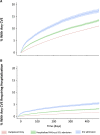Coronavirus Disease 2019 Severity and Risk of Subsequent Cardiovascular Events
- PMID: 35984816
- PMCID: PMC9907540
- DOI: 10.1093/cid/ciac661
Coronavirus Disease 2019 Severity and Risk of Subsequent Cardiovascular Events
Abstract
Background: Little is known about the relationship between coronavirus disease 2019 (COVID-19) severity and subsequent risk of experiencing a cardiovascular event (CVE) after COVID-19 recovery. We evaluated this relationship in a large cohort of United States adults.
Methods: Using a claims database, we performed a retrospective cohort study of adults diagnosed with COVID-19 between 1 April 2020 and 31 May 2021. We evaluated the association between COVID-19 severity and risk of CVE >30 days after COVID-19 diagnosis using inverse probability of treatment-weighted competing risks regression. Severity was based on level of care required for COVID-19 treatment: intensive care unit (ICU) admission, non-ICU hospitalization, or outpatient care only.
Results: A total of 1 357 518 COVID-19 patients were included (2% ICU, 3% non-ICU hospitalization, and 95% outpatient only). Compared to outpatients, there was an increased risk of any CVE for patients requiring ICU admission (adjusted hazard ratio [aHR], 1.80 [95% confidence interval {CI}, 1.71-1.89]) or non-ICU hospitalization (aHR, 1.28 [95% CI, 1.24-1.33]). Risk of subsequent hospitalization for CVE was even higher (aHRs, 3.47 [95% CI, 3.20-3.76] for ICU and 1.96 [95% CI, 1.85-2.09] for non-ICU hospitalized vs outpatient only).
Conclusions: COVID-19 patients hospitalized or requiring critical care had a significantly higher risk of experiencing and being hospitalized for post-COVID-19 CVE than patients with milder COVID-19 who were managed solely in the outpatient setting, even after adjusting for differences between these groups. These findings underscore the continued importance of preventing severe acute respiratory syndrome coronavirus 2 infection from progressing to severe illness to reduce potential long-term cardiovascular complications.
Keywords: PASC; SARS-CoV-2; long COVID; post-COVID syndrome; postacute COVID-19 syndrome.
© The Author(s) 2022. Published by Oxford University Press on behalf of the Infectious Diseases Society of America.
Conflict of interest statement
Potential conflicts of interest. All authors are employees and shareholders of Pfizer Inc. All authors have submitted the ICMJE Form for Disclosure of Potential Conflicts of Interest. Conflicts that the editors consider relevant to the content of the manuscript have been disclosed.
Figures



References
Publication types
MeSH terms
LinkOut - more resources
Full Text Sources
Medical
Miscellaneous

